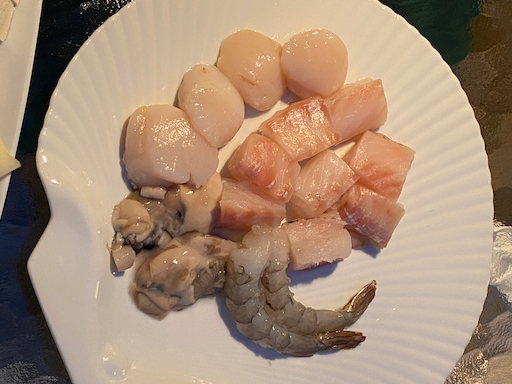Actually, this was inspired by a dish we had at Sushi Taro Omakase and then by a variation that was in the
2020 osechi box and was called "kaki kaki kunsei" (Smoked oyster and persimmon). In Japanese, persimmon is "Kaki" with flat intonation and oyster is "Kaki" with an accent on "ki", so this was a sort of play on words. The quality of the smoked oysters and persimmon are important. The oysters used by Sushi Taro were smoked in-house and were wonderful. The persimmon was perfection. The osechi version of this dish (picture below) had a light olive oil-based dressing and was also extremely good. In the case of the dish I made, the importance of the quality of ingredients was driven home in spades. Both the oysters and the persimmon were not really great but the basic recipe is good so after several iterations we finally came up with a dish that was not bad.
We found a package of "kaki" persimmon 柿 from California at Whole Foods. It looked like
"Shibu-gaki" 渋柿 meaning "puckering persimmon". But these must have been treated. There are multiple ways this could have been done. For example it could have been treated with carbon dioxide since this was apparently commercially done. (The "at-home" treatment to reduce the puckering effect is usually to wait until the persimmon is completely ripe and becomes somewhat gelatinous). The advertisement on the package stated "you can eat it as it is" and showed a cherub of a boy eating it like an apple.
Since the persimmon we bought were supposedly ready to eat, we tried it. It was still hard. Although it was not puckering, the "persimmon" flavor was not as pronounced as we would have liked. As the first iteration of trying this persimmon, I made "shira-ae" 白和え a very common small dish which I
blogged previously.
For the next iteration I served the persimmon with canned smoked oysters as my attempt to emulate what we had at Sushi Taro. Unfortunately, the canned smoked oysters which came from China and were bought at our local grocery store (shown as the bottom can in the picture below) were, as far as we were concerned, not suitable for human consumption. The oysters were fragmented, almost black in color and tasted terrible. They completely ruined the dish.
For the third iteration I used smoked canned oysters in olive oil from Whole Foods (shown as the top can in the picture above). (We didn't look to see where they came from). These were infinitely better than the previous batch. They were plump, whole and had a nice smokey flavor. This dish is shown below.
The strong smokey taste of the oysters and the sweetness of the persimmon' with the gentle sesame punctuated flavored dressing of tofu worked well.
This was one of three small starter dishes I served one evening with cold sake.
Of the other two dishes, the left most is
fried salmon in sweet vinegar 鮭の南蛮漬け. I garnished it with sushi vinegar dressed cucumber キュウリの酢の物.
The center dish is my usual
mackerel simmered in miso サバの味噌煮.
Ingredients:
One persimmon peeled and cut into bite sized pieces (below left).
One can of smoked oysters in olive oil.
For the Shira-ae dressing 白和え (below right)
1/4 silken tofu, wrapped in paper towel and weighted down to remove extra moisture.
1 tsp miso (or to taste)
1/4 tsp roasted sesame seeds, ground in a Japanese suri-bachi すり鉢 mortar.
1/4 tsp of light colored soy sauce
Directions:
Add all the shira-ae ingredients to a Japanese suribachi mortar and grind them until smooth (above right). Taste and if need adjust the seasoning.
Dress the persimmon pieces and top with the oysters. (I blotted off any excess oil and cut the oysters into two pieces.
Compared to the first try with oysters, this second try was much better. (As good as it was it did not hold a candle to the Sushi Taro version). I do not think this type of persimmon is particularly good for this dish. I prefer another kind of non-puckering persimmon called
"ama-gaki"甘柿. It has a better texture, is sweeter, and has a stronger distinctive persimmon flavor. In any case, the contrast of the flavor of the persimmon with tofu dressing and smokey oyster flavors worked well enough.















